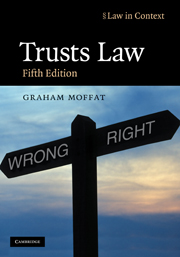Book contents
- Frontmatter
- Contents
- Preface to the fifth edition
- Acknowledgments
- Table of abbreviations
- Useful websites
- Table of statutes
- Table of statutory instruments
- Table of cases
- 1 Trusts introduced
- 2 The evolution of the private express trust
- 3 Taxation, wealth-holding and the private trust
- 4 Creating the trust – I
- 5 Creating the trust – II
- 6 Trusts and public policy
- 7 Flexibility in relation to beneficial entitlement
- 8 The taxation of private trusts
- 9 An introduction to trustees and trusteeship
- 10 Aspects of the management of trusts
- 11 Trusteeship, control and breach of trust
- 12 Implied trusts and the family home
- 13 Trusts in commerce I: occupational pension schemes
- 14 Trusts in commerce II: commerce and equitable remedies
- 15 Trusts in commerce III: commerce, credit and the trust
- 16 Trusts in commerce IV: fiduciary relationships, commerce and the trust
- 17 Trust, contract and unincorporated associations
- 18 An introduction to the law of charity
- 19 A legal definition of ‘charity’
- 20 The regulation of charities
- Index
3 - Taxation, wealth-holding and the private trust
- Frontmatter
- Contents
- Preface to the fifth edition
- Acknowledgments
- Table of abbreviations
- Useful websites
- Table of statutes
- Table of statutory instruments
- Table of cases
- 1 Trusts introduced
- 2 The evolution of the private express trust
- 3 Taxation, wealth-holding and the private trust
- 4 Creating the trust – I
- 5 Creating the trust – II
- 6 Trusts and public policy
- 7 Flexibility in relation to beneficial entitlement
- 8 The taxation of private trusts
- 9 An introduction to trustees and trusteeship
- 10 Aspects of the management of trusts
- 11 Trusteeship, control and breach of trust
- 12 Implied trusts and the family home
- 13 Trusts in commerce I: occupational pension schemes
- 14 Trusts in commerce II: commerce and equitable remedies
- 15 Trusts in commerce III: commerce, credit and the trust
- 16 Trusts in commerce IV: fiduciary relationships, commerce and the trust
- 17 Trust, contract and unincorporated associations
- 18 An introduction to the law of charity
- 19 A legal definition of ‘charity’
- 20 The regulation of charities
- Index
Summary
Introduction
As Hubert Monroe lugubriously commented in a Hamlyn Lecture ‘tax is scarcely a favourite topic’ (Intolerable Inquisition? Reflections on the Law of Tax (1981) p 1). It is not difficult to endorse this sentiment particularly when applied to the taxation of trusts. In academic contexts the topic conventionally falls into a no-man's land between the separate domains of taxation and trusts. Yet even by the beginning of the twentieth century the incidence of taxation was influencing the development of the private express trust. Indeed, as will be seen later in this book, taxation or more appropriately the availability of relief from taxation, has exercised considerable influence on public types of trusts also – for example, pension funds and charities (see Chapters 13, 18 and 19). With respect to private trusts, however, it may be claimed that this influence has so increased that fiscal considerations now dominate trusts practice even if not directly the formal rules of trusts law. Whether trusts should be created, what types of trust should be adopted and where their administration should be located are all, in reality, decisions taken by property owners only after careful consideration of the fiscal implications.
The claim that these implications predominate will be probed later in this chapter (see p 75) but at the very least the taxpayer is unlikely to be satisfied with a tax lawyer or accountant who merely clarifies the probable size of the tax bill based on existing property arrangements.
- Type
- Chapter
- Information
- Trusts LawText and Materials, pp. 72 - 115Publisher: Cambridge University PressPrint publication year: 2009



